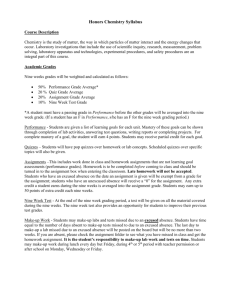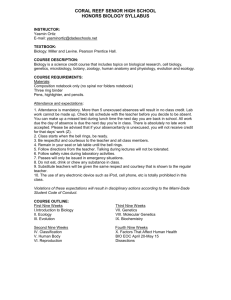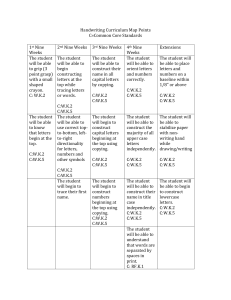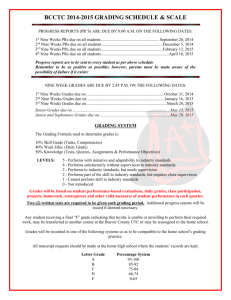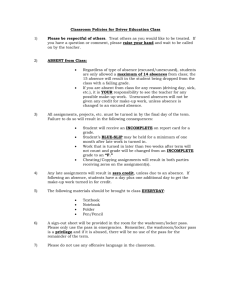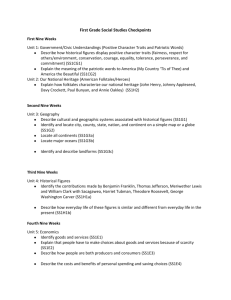General Chemistry Syllabus
advertisement
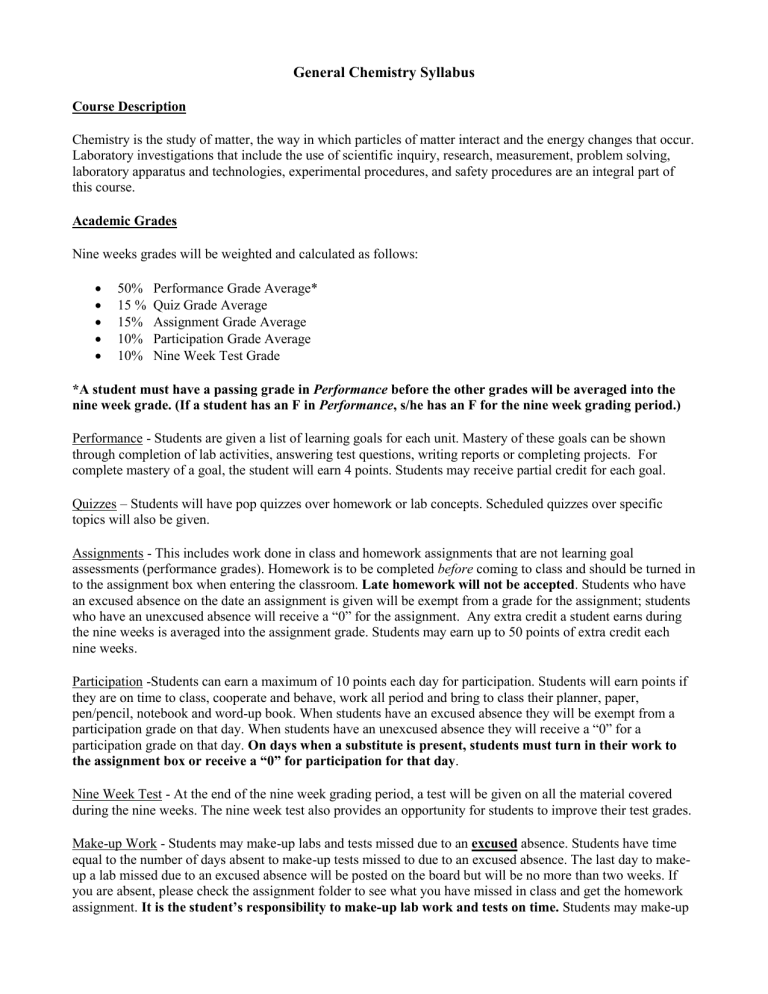
General Chemistry Syllabus Course Description Chemistry is the study of matter, the way in which particles of matter interact and the energy changes that occur. Laboratory investigations that include the use of scientific inquiry, research, measurement, problem solving, laboratory apparatus and technologies, experimental procedures, and safety procedures are an integral part of this course. Academic Grades Nine weeks grades will be weighted and calculated as follows: 50% 15 % 15% 10% 10% Performance Grade Average* Quiz Grade Average Assignment Grade Average Participation Grade Average Nine Week Test Grade *A student must have a passing grade in Performance before the other grades will be averaged into the nine week grade. (If a student has an F in Performance, s/he has an F for the nine week grading period.) Performance - Students are given a list of learning goals for each unit. Mastery of these goals can be shown through completion of lab activities, answering test questions, writing reports or completing projects. For complete mastery of a goal, the student will earn 4 points. Students may receive partial credit for each goal. Quizzes – Students will have pop quizzes over homework or lab concepts. Scheduled quizzes over specific topics will also be given. Assignments - This includes work done in class and homework assignments that are not learning goal assessments (performance grades). Homework is to be completed before coming to class and should be turned in to the assignment box when entering the classroom. Late homework will not be accepted. Students who have an excused absence on the date an assignment is given will be exempt from a grade for the assignment; students who have an unexcused absence will receive a “0” for the assignment. Any extra credit a student earns during the nine weeks is averaged into the assignment grade. Students may earn up to 50 points of extra credit each nine weeks. Participation -Students can earn a maximum of 10 points each day for participation. Students will earn points if they are on time to class, cooperate and behave, work all period and bring to class their planner, paper, pen/pencil, notebook and word-up book. When students have an excused absence they will be exempt from a participation grade on that day. When students have an unexcused absence they will receive a “0” for a participation grade on that day. On days when a substitute is present, students must turn in their work to the assignment box or receive a “0” for participation for that day. Nine Week Test - At the end of the nine week grading period, a test will be given on all the material covered during the nine weeks. The nine week test also provides an opportunity for students to improve their test grades. Make-up Work - Students may make-up labs and tests missed due to an excused absence. Students have time equal to the number of days absent to make-up tests missed to due to an excused absence. The last day to makeup a lab missed due to an excused absence will be posted on the board but will be no more than two weeks. If you are absent, please check the assignment folder to see what you have missed in class and get the homework assignment. It is the student’s responsibility to make-up lab work and tests on time. Students may make-up work during lunch every day but Friday, during 4th or 5th period with teacher permission or after school on Monday, Wednesday or Friday. Behavior and Class Procedures As stated in the section on participation grades, students are expected to be on time to class, cooperate and behave, work all period and bring to class their planner, paper, pen or pencil, notebook and word-up book. When a student finishes class work for the day, s/he may work on an assignment from another class or read the word-up book until the rest of the class is finished. Please respect yourself and the other students and teachers in the classroom. No put-downs are allowed, not even as a joke. Please watch your language; only school-appropriate language should be used in the classroom. Do not interrupt the speaker in the classroom; raise your hand and wait to be called on if you have a question, comment or answer for a question. Keep your desk and work area clean; throw garbage in the garbage can and paper in the recycling bin. Because we have restrooms in the classroom, you may use the restroom without asking permission. Food and drink, except for clear water, are not permitted in class and paybacks will be given. No electronic devises except calculators are allowed in class. Cell phones should not be visible during class; students who have cell phones visible in class will receive a payback and the phone will be confiscated for the day. On the second cell phone offense, a parent will have to come to school to pick up the phone. Cheating will not be tolerated. Cheating includes but is not limited to access to any test or quiz information whether written on paper, on your skin or clothing or any electronic device. A student in possession of any electronic device during a test or quiz will be assumed to be cheating. Any student caught cheating will receive a zero on the test or quiz and a payback. Parents will be notified. Students should be ready to begin class when the bell rings. Materials for class should be on the table and backpacks stored. Students who have an excused tardy must bring a note which includes the student’s name, date and time and it must be signed by a staff member. Students will receive a payback on their third unexcused tardy in a nine week period and on any subsequent unexcused tardy during the nine week period. On the fourth unexcused tardy for the nine week period parents will be notified. Conduct Grades Conduct grades are based on a student’s attitude and behavior in class. The following criteria will be used to assign conduct grades: Shows respect to others. Cooperates and behaves in class. Works safely in labs. Participates in class discussions and activities. Comes to class prepared and on time. Contact Information Parents and students may contact me by email (Thompsons@leonschools.net) or by phone (488-2468) on any school day. General Chemistry Learning Goals I. Chemistry: Study of Matter (Chapters 1, 2, 11) A. Scientific Method (2) 1. Identify statements as scientific, nonscientific or pseudo-scientific. (T) 2. Identify characteristics of the scientific method. (T) 3. Use the scientific method to investigate a chemical reaction. (Lab: A Color Change Mystery) 4. Compare and contrast the methods and results of two scientists working separately on the same question. (P) 5. Distinguish between accuracy and precision in measurements and apply rules for significant figures. (Lab: Density of Aluminum) B. Energy and Matter (1, 2, 11) 1. Classify changes in matter as physical or chemical. (Lab: Physical and Chemical Changes) 2. Classify matter using various criteria. (Lab: Classifying Matter) 3. Name specific energy transformations. (T) 4. Describe the transfer of energy in chemical and physical changes and apply the Law of Conservation of Energy when analyzing changes in matter. (Lab: Energy and Physical Reactions) 5. Distinguish between heat and temperature and calculate the heat change in a system using the change in temperature. (Lab: Heat Transfer) II. The Atom: The Basic Particle of Matter (Chapters 3, 4, 18) A. Atomic Structure (Chapter 3) 1. Compare and contrast Democritus', Dalton's, Thomson's and Rutherford's models of the atom. (T) 2. Identify the evidence for the existence of electrons and protons. (T) 3. Identify the properties of protons, electrons and neutrons. (T) 4. Determine the number of particles in the nucleus of an isotope and write isotope names and symbols. (T) 5. Calculate the average atomic mass of an element. (Lab: Isotopes of Pennium) B. Atomic Nucleus (Chapter 18) 1. Identify the characteristics of the four forces in nature. (T) 2. Identify factors affecting nuclear stability. (T) 3. Identify the properties of radioactive decay emissions. (T) 4. Predict the particles and electromagnetic waves produced by different types of radioactive decay and complete equations for nuclear decay. (T) 5. Determine the amount of radioactive isotope left after a given amount of time and determine the new isotope that has formed. (T) **6. Discuss the process and importance of nuclear fission and fusion. (T) 7. Graph and analyze half-life data generated in the lab. (Lab: Half-life of Pennium) C. Electron Configuration (Chapters 3) 1. Compare and contrast the Rutherford, Bohr and Quantum models of the atom. (T) 2. Explain how the wavelengths of light emitted by an atom provide information about electron energy levels. (Lab: Flame Test) 3. Identify the significant information about the four quantum numbers. (T) 4. Write the electron configuration and draw a Bohr model of an atom. (T) D. Periodic Table (4) 1. Locate the different families of main group elements on the periodic table, identify their characteristic properties, and relate their properties to their electron configurations. (T) 2. Describe the periodicity of a specific property of elements within a family. (Lab: Density in the Carbon Family) III. Combining Atoms: Chemical Compounds (Chapters 5, 6, 13, 15, 19) A. Ionic Bonds and Ionic Compounds (5) 1. Express ionic compounds in various notations. (T) 2. Identify information about the process of ionic bond formation and the structure and properties of the resulting salt crystal. (T) 3. Determine the formulas for ionic compounds based on experimental data. (Lab: Ionic Compound Formulas) 4. Describe the source and usefulness of a specific ionic compound. (P) B. Covalent Bonds and Molecular Compounds (6, 19) 1. Express molecular compounds in various notations. (T) 2. Identify information about the bond properties and stability of molecular compounds. 3. Determine the electronegativity difference and bond type for a given compound. (T) 4. Identify the special properties of carbon atoms and specific functional groups. (T) C. Water and Solutions (13, 15) 1. Identify the water molecule's properties and how they are related to its shape. (T) 2. Determine the type of mixture based on its properties (Lab: Classification of Mixtures) 3. Recognize the differences among hydrogen bonding, van der Waals forces and ionic and covalent bonding. (T) 4. Demonstrate how the properties of compounds depend on the nature of their bonds. (Lab: Conductivity and Bond Type) 5. Determine how the freezing point of water is affected by the addition of a solute. (Lab: What’s the Freezing Point?) 6. Identify properties of acid, base and salt solutions. (T) 7. Identify the relationship between pH and hydronium and hydroxide ion concentration. (T) 8. Distinguish between acidic and basic solutions. (Lab: Acids and Bases) IV. Compound Interactions: Chemical Changes (Chapters 8, 9, 16) A. Chemical Reactions and Equations (8, 9) 1. Demonstrate and discuss conservation of mass in chemical reactions. (Lab: Bags of Reactions) 2. Interpret a formula equation and notations such as those related to states of reactants and products and reaction conditions. (T) 3. Balance a formula equation. (T) 4. Solve stoichiometry problems involving mass by using molar mass and mole ratios. (T) B. Reaction Rate (16) 1. Determine the effect of temperature and surface area on reaction rate and relate it to collision theory. (Lab: Rates of an Antacid Reaction) 2. Determine the effect of concentration on reaction rate and relate it to collision theory. (Lab: Concentration and Reaction Rate) 3. Explain what is involved in determining reaction rate including the role of activation energy and collision orientation. (T) 4. Interpret a reaction rate graph. (T) 5. Identify ways in which concentration, temperature, pressure, surface area and the presence of a catalyst may affect the rate of a reaction. (T) C. Classifying Chemical Reactions (8) 1. Demonstrate and describe composition and decomposition reactions (Lab: Composition and Decomposition Reactions) 2. Use the results of single replacement reactions to create a simple activity series. (Lab: Reactivity of Metals in Displacement Reactions) 3. Demonstrate and describe double replacement reactions (Lab: Double Replacement Reactions) 4. Identify composition, decomposition, single replacement, and double replacement and combustion reactions. (T) V. Gases (Chapter 12) A. Gas Laws 1. Relate the kinetic-molecular theory to the properties of an ideal gas. (T) 2. Demonstrate Boyle’s Law (Lab: Boyle's Law) 3. Demonstrate Charles' Law (Lab: Charles' Law) 4. Use the gas laws to solve problems involving temperature, pressure and volume. (T) 5. Solve problems using the ideal gas law. (T) B. Gas Properties 1. Compare reactions of oxygen gas in different situations. (Lab: Generating and Collecting Oxygen) 2. Compare reactions of hydrogen gas in different situations. (Lab: Generating and Collecting Hydrogen)
